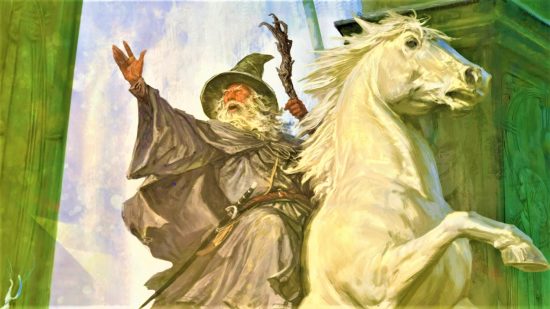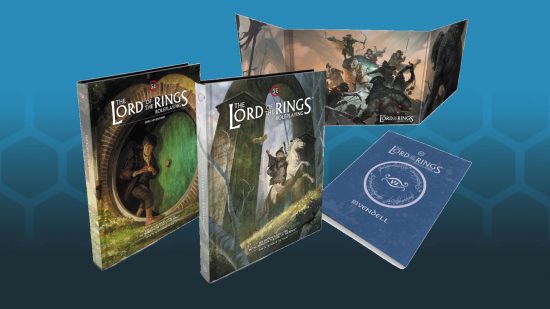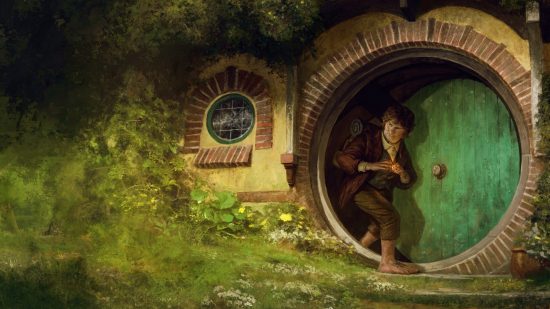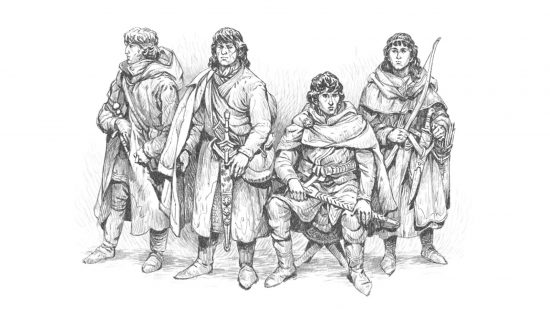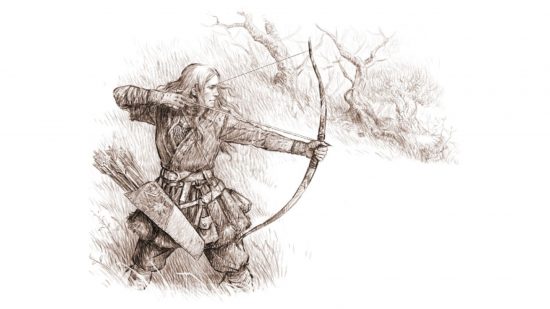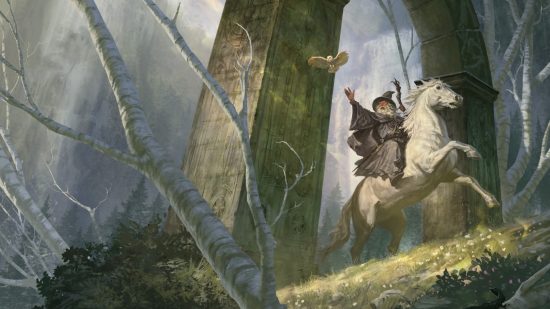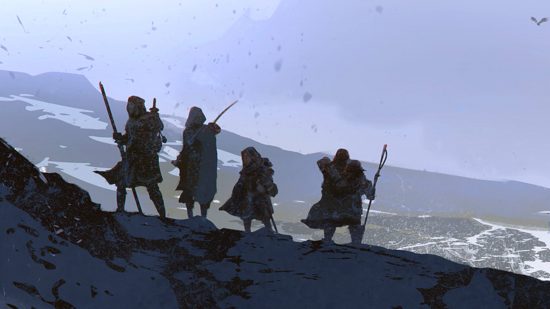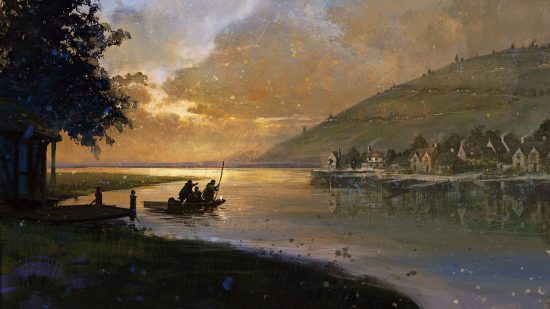It’s hard to find a corner of the tabletop RPG world that hasn’t been touched by The Lord of the Rings. Dungeons and Dragons, the original roleplaying game, was so heavily inspired by the fantasy classic that The Tolkien Estate quite literally took legal action against it. The hobbit may have become the DnD Halfling, but Middle-earth’s influence over tabletop roleplaying continued under new names.
It was only a matter of time before a Lord of the Rings roleplaying game emerged from the brush. And now, in the year 2023, we have two: The Lord of the Rings Roleplaying and The One Ring 2e. The former is a D&D 5e port of the latter. Both are currently published by Free League, and they also share a designer – Francesco Nepitello.
Between heading up CMON’s RPG division and working as a freelance game designer, Nepitello has designed War of the Ring, The One Ring, and Lord of the Rings 5e. If anyone knows Tolkien tabletop games, it’s him. Wargamer stopped for some second breakfast with Nepitello to talk all things Lord of the Rings 5e – namely, how Tolkien’s work is translated to the tabletop, and why The Lord of the Rings Roleplaying exists in the first place.
WG: You’ve got a lot of experience adapting The Lord of the Rings for the tabletop. What’s your history with the books, and what do you love about them?
FN: It’s something that I first encountered when I was probably about 11 or 12. It was not immediately love at first sight. It was something I wanted to read because a lot of friends of mine were into it, but it took a while for me. To overcome the first chapters of The Lord of the Rings, I had to be home sick for a week. But then it stayed with me forever.
There were always parallels, being into games. The Lord of the Rings is the original fantasy, so even when I started playing D&D and other games, Tolkien was always there as a reference, even if we never played too much with the material in roleplaying games at the time. I considered [RPGs] to be excessively different from the books, and I was a sort of purist as far as the text was concerned. For a long time, I considered the Tolkien stories to be unplayable.
And then, in 2004, we published War of the Ring. That went on to become a classic, and it’s been on the market more than 18 years in 11 languages or more. That game established me as designers that could translate the work of Tolkien into something playable. And so I was challenged by a company in Spain, who told me ‘The Lord of the Rings licence is out there, and nobody’s picking it up – we’re interested in having you design the game’. It took me more than two years to design the game [The One Ring], but it was something of a dream come true.
Why did you initially think The Lord of the Rings couldn’t work as a tabletop RPG?
It was because the story was everything to me. Back then, I was not thinking about Middle-earth as a real place; I was thinking about the story, and couldn’t really separate those two things. Unless it [an RPG] came from the last writings of the author, I always felt like we were playing with the toys of someone else – even if Tolkien had, in theory, wanted people to pick up his creation and continue it.
Tolkien designed something so carefully, and with so many details, that whenever somebody tried to do something in the same vein, it always came out shallow by comparison. When it came to designing our own RPG for The Lord of the Rings, the main question was ‘how can we do this without telling the same story over and over again? And how can we do this without making players feel like shadows of the real characters?’
We did this by looking closely at the story – there are so many spin-off tales that can be told around it, because Tolkien hints at so many things that are happening at the same time. We began to look outside the main story, at all the possible stories that can be told or can be imagined, ones that went parallel with the main story of The Hobbit and The Lord of the Rings.
Since Tolkien’s world doesn’t use magic the way fantasy media like D&D does, how will The Lord of the Rings 5e handle magic?
The answer is simple, because we’ve used all the design choices we made previously with The One Ring. Since the game was published in 2011, we’ve had quite a bit of feedback over time that told us our design choices were on the right path.
In the beginning [with The One Ring], there was some resistance to the idea of a Tolkien game with such little magic in the hands of the players in the traditional RPG sense. But actually, magic is totally built into the world. All the character types present in the game have magic in one way or another.
We used the point of view that Tolkien used in his books – where some subcultures have abilities that are so specialised and effective, it may look like magic to others. Even Hobbits, who look like the most plain and mundane creatures, and who really represent the average person, have abilities that look like magic to others. They can be incredibly stealthy, they can disappear, and they can strongly resist corruption.
And men, who are often considered vanilla characters in roleplaying games, have different abilities. If you come from Dale, for example, you have an affinity with birds. All that, for me, makes for an authentic, legendary sort of feel for the game.
With the port, we’ve brought all of these mechanics into the D&D 5e frame. That meant completely ignoring classes like DnD Wizards and DnD Sorcerers and all magic-using in the traditional sense of DnD classes. Players may be disappointed at first they can’t play a Wizard, but if you played a Wizard, it wouldn’t feel like The Lord of the Rings.
Were there any challenges to translating The One Ring for a different system?
I had to rely on a good friend of mine, Michele Garbuggio, who took charge of coming up with mechanics that felt right for the fifth edition player. I’ve played fifth edition, but I’m not a veteran player, so I needed somebody more proficient with that. While it was very easy to say ‘yes, we’re going to translate all the abilities and characters in the same way we did for The One Ring’, it was not easy to do that right.
For example, there was already a translation of The One Ring for fifth edition called Adventures in Middle-earth. This tried to adopt everything from The One Ring 1e, but in some cases had to make different but parallel versions of rules. Adventures in Middle-earth did a very good job on many fronts, but it suffered a bit from balancing issues between the classes, something that is more important in fifth edition than in other types of games.
What kind of player did you have in mind when designing The Lord of the Rings 5e? Is the hope that this RPG will introduce people to The One Ring and wider tabletop adaptations of The Lord of the Rings?
The aim was twofold. On one side, we knew there were a number of fans who were orphaned by the demise of Adventures in Middle-earth. When we went to Free League to make this evolution of [The One Ring 2e], we knew that eventually we would want to do a fifth edition version to give those players their game back. It will allow them to continue following the game line, as everything that comes out for The One Ring will also be available for The Lord of the Rings 5e.
The other reason we did [Lord of the Rings 5e] is because we realised that D&D players and other RPG players do not really occupy the same space. Many D&D players aren’t interested in playing other games, and sometimes vice versa. We knew that The One Ring would reach a certain audience, but it might not reach the other – which is why The Lord of the Rings 5e exists.
We were very lucky that The One Ring 2e broke through a certain roof that we thought was there for games that weren’t based on fifth edition. The game was incredibly successful on Kickstarter and continues to do well. Its first edition incarnation sold well, but it remained a niche thing, while The One Ring 2e has gotten even more popular in gaming circles. I’m really happy The One Ring is standing on its own legs and doesn’t need fifth edition to be more popular – but if a D&D player discovers The One Ring through The Lord of the Rings 5e and wants to try it, that’s a plus.
What aspects of the new RPG books are you most proud of?
I’m proud of the fact that everything that we designed for The One Ring was easily ported over. All the original stuff we thought would make the perfect game for Tolkien could still work [in fifth edition] without any problems.
I’m also really happy about the graphic design that was chosen by Free League. I’m talking about the covers, because mostly the art inside of the game is the same in the two editions. But the covers for The One Ring are in this darker, more impressionist style, while for The Lord of the Rings 5e, there are well-known characters on the covers, and a very nice fight scene on the GM screen. It’s also exciting for me when I worked for a long time on The One Ring to see that there is something to look forward to for the new edition because of the new covers.
